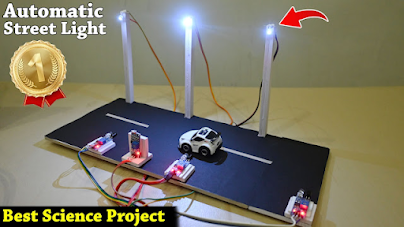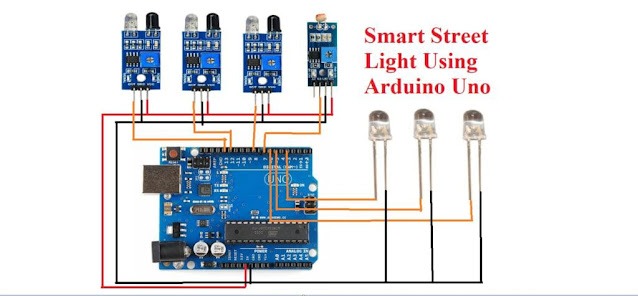Automatic Smart Street Light | Best science Project
**Automatic Smart Street Light** This project develops a self-regulating street light system. It uses sensors (light, motion) to control LEDs, switching off during daylight and dimming when inactive. This enhances energy efficiency, reduces light pollution, and improves safety.
SCIENCE PROJECTS




# circuit diagram
Creating an Automatic Smart Street Light system involves several steps, from gathering the necessary components to programming the microcontroller. Here’s a detailed guide to help you build this project from start to finish.
### Components Needed
1. Microcontroller: Arduino Uno or Raspberry Pi
2. Light Sensor: LDR (Light Dependent Resistor) or a photoresistor
3. Motion Sensor: PIR (Passive Infrared) sensor
4. Relay Module: To control the LED lights
5. LED Street Light: High-power LED or an array of LED lights
6. Resistors: For circuitry (e.g., 10k ohm for LDR)
7. Breadboard/Wiring: For prototyping connections
8. Jumper Wires: For making connections
9. Power Supply: Appropriate power source for the Arduino and LEDs (battery or adapter)
10. Enclosure: To house the components and protect them from environmental factors
### Step-by-Step Process
#### Step 1: Design the System
1. Understand the Workflow:
- The system will automatically turn on the street light when ambient light is low and increase its brightness when motion is detected (e.g., passing pedestrians or vehicles).
2. Plan the Circuit:
- Decide on the placement of the sensors and lights. The LDR should be positioned to accurately detect surrounding light levels, while the PIR sensor should be aimed at areas with expected movement.
#### Step 2: Assemble the Circuit
1. Wiring the Light Sensor (LDR):
- Connect the LDR in a voltage divider configuration:
- One terminal of the LDR connects to 5V.
- The other terminal connects to an analog input pin (e.g., A0) on the Arduino and a resistor (e.g., 10k ohm) to ground.
2. Wiring the Motion Sensor (PIR):
- Connect the PIR sensor:
- Connect the VCC pin to 5V.
- Connect the GND pin to ground.
- Connect the OUT pin to a digital input pin (e.g., pin 2) on the Arduino.
3. Wiring the Relay Module:
- Connect the relay to control the LED lights:
- Connect the signal pin of the relay to a digital output pin (e.g., pin 3) on the Arduino.
- Connect the VCC and GND of the relay to 5V and ground.
4. Connecting the LED Lights:
- Wire the LED lights to the relay according to the relay’s specifications, ensuring it can safely handle the voltage and current.
#### Step 3: Write the Arduino Code
1. Install the Arduino IDE:
- If you haven't already, download and install the Arduino IDE.
2. Program the Code:
- Write the code to read values from the LDR and PIR sensors to control the operation of the street lights. Below is a sample code snippet:
```cpp
// Pin assignments
const int ldrPin = A0; // LDR sensor pin
const int pirPin = 2; // PIR sensor pin
const int relayPin = 3; // Relay pin
void setup() {
pinMode(relayPin, OUTPUT);
pinMode(pirPin, INPUT);
digitalWrite(relayPin, LOW); // Ensure relay is off initially
Serial.begin(9600);
}
void loop() {
int ldrValue = analogRead(ldrPin); // Read LDR value
int pirValue = digitalRead(pirPin); // Read PIR status
Serial.println(ldrValue); // Print LDR value for debugging
// Check ambient light level and PIR status
if (ldrValue < 500) { // Adjust threshold based on testing
if (pirValue == HIGH) {
digitalWrite(relayPin, HIGH); // Turn on light
} else {
digitalWrite(relayPin, LOW); // Keep light off if no motion
}
} else {
digitalWrite(relayPin, LOW); // Turn off light if it's bright
}
delay(1000); // Delay for stability
}
```
3. Upload the Code:
- Connect the Arduino to your computer and upload the code via the Arduino IDE.
#### Step 4: Testing the System
1. Power the System:
- Connect the power supply to the Arduino and the relay module.
2. Simulate Conditions:
- Test the system by covering the LDR to simulate low light conditions and moving in front of the PIR sensor to see if the street light turns on appropriately.
3. Adjust Sensitivity and Thresholds:
- Monitor and adjust the thresholds in the code based on your testing results and the environment to ensure optimal performance.
#### Step 5: Final Assembly and Deployment
1. Secure the Components:
- Once testing is complete, secure all components in a suitable enclosure to protect them from weather conditions.
2. Install the System:
- Place the smart street light system in a designated area where it can effectively monitor ambient light and movement.
3. Regular Maintenance:
- Periodically check the system to ensure all components are functioning properly and to adjust settings as necessary based on changes in the environment.
### Conclusion
By following these steps, you've successfully created an Automatic Smart Street Light that not only saves energy but also enhances safety in public spaces. This project demonstrates the practical applications of Arduino for smart city solutions and paves the way for further enhancements, such as remote monitoring or integration with other smart systems.
If you have any questions or need further guidance on specific aspects of the project, feel free to ask!
